
Amiko Matsuo
[T]he Echigo-Tsumari Art Triennale in the mountainous Niigata region of Japan has become a model, yet an underappreciated one, for expansive social art practices. Through active pursuit of dialogue that links art with community development rooted in place-making and place identity, its founder and director Kitagawa Fram has long been asserting what Lucy Lippard has more recently called for in the future of land-based art: “A vernacular land art might include commemoration that looks to the smaller scale, land-based notions of nature, remembering small farms and common lands, the disappearing histories of places and ecosystems.”
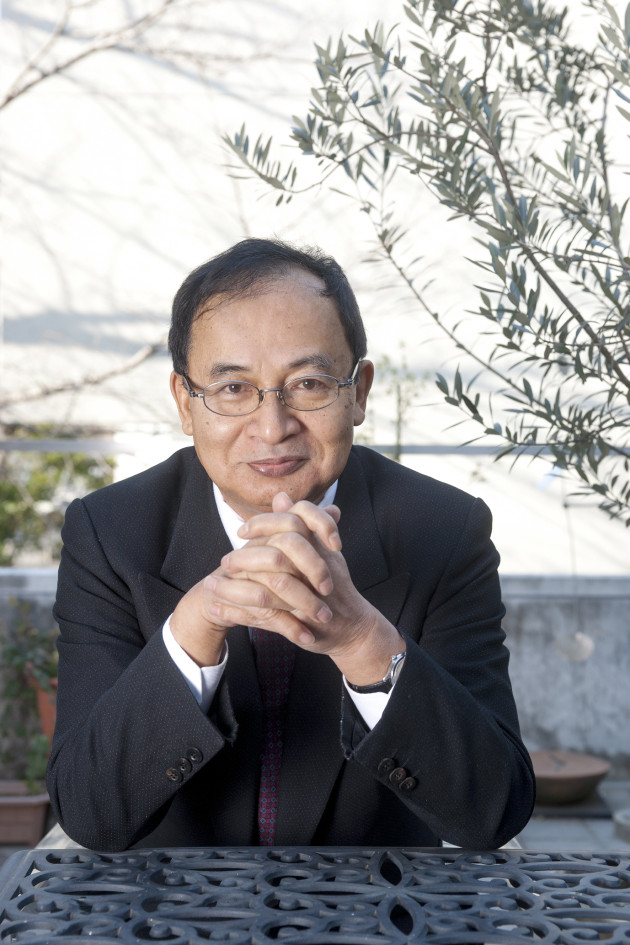 More importantly, however, the restorative efforts of Kitagawa and the Echigo-Tsumari Art Triennale have endured in the face of the economic recession, the Chūetsu earthquake of 2007, polarization of the urban and the rural, and the economic effects of the devastating earthquake and tsunami of November 2011. It is time for the West to recognize the optimism these art projects inspire in the residents of the region. Such awareness would lead more Western artists to view Echigo-Tsumari as a model for transformative art on the scale of Kitagawa’s activist vision. This model could inspire, for example, more work in the vein of Theaster Gates, the American ceramic and social practice installation artist, who said artists should do more than just make objects. Rather, we should “make the thing that makes the thing.” We should transform culture.
More importantly, however, the restorative efforts of Kitagawa and the Echigo-Tsumari Art Triennale have endured in the face of the economic recession, the Chūetsu earthquake of 2007, polarization of the urban and the rural, and the economic effects of the devastating earthquake and tsunami of November 2011. It is time for the West to recognize the optimism these art projects inspire in the residents of the region. Such awareness would lead more Western artists to view Echigo-Tsumari as a model for transformative art on the scale of Kitagawa’s activist vision. This model could inspire, for example, more work in the vein of Theaster Gates, the American ceramic and social practice installation artist, who said artists should do more than just make objects. Rather, we should “make the thing that makes the thing.” We should transform culture.
To understand the dialogic nature of Echigo-Tsumari art festivals in Niigata, Japan over the last 15 years, one begins with the Japanese concept of satoyama,“an ideal of ecological woodland restoration meant to foster and strengthen nature-culture linkages.” Kitagawa’s festival-based community building, or machizukuri, in Echigo-Tsumari highlights the connections between the local residents and traditional lifeways and satoyama practices. Over the course of five Triennali to date, artworks have occupied akiya (unoccupied traditional houses) and greyfields, abandoned schools and storefronts, as well as terraced rice fields as part of a pattern of adaptive reuse. Kitagawa Fram and the community, through grassroots efforts, have been working toward incorporating the notion of “satoyama” prior to the rest of the world’s exposure to the idea. As part of their place identity, they pride themselves on the agroecology of the terraced rice fields built like shelf mushrooms into the dramatically hilly terrain of the Echigo-tsumari region. The rice fields are the result of many generations of cultivation, and despite their value in maintaining ecosystems dependent upon traditional agri/culture, the Japanese government in the past has labeled them “inefficient,” and the corresponding lack of support threatens the conservation of these traditional productive landscapes. In contrast to this, Echigo-Tsumari Art Triennial has recognized that the fields represent a communal and ecological achievement in a landscape characterized by the challenges of heavy snow in the winter, earthquakes, and landslides.
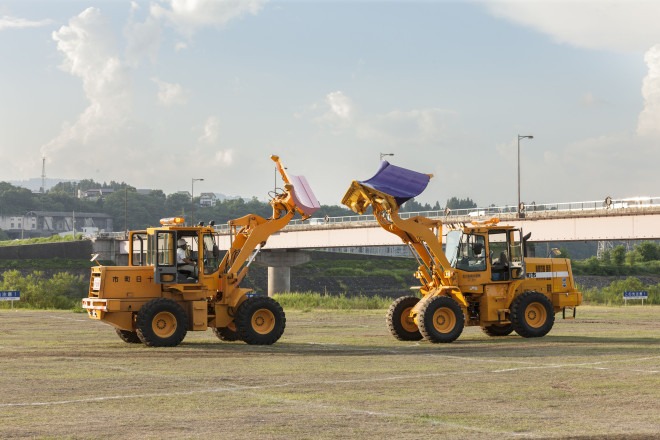
Kitagawa’s work deserves more attention in the West (and specifically the United States) for his production of the Echigo-Tsumari projects starting in 2000. By furthering dialogue about globalization, the local, and even the notion of re-invented localities, Kitagawa’s work is notable for its contemporaneity, in Reiko Tomii’s sense of the multiplicitous production of art where there is a dialogue between past and present. This is especially relevant today when critics are calling for decentering and revision of modernist history, such that Japanese modernism is re-evaluated in the context of international modernisms. In this vein, recent critical work provides the backdrop to recognizing Kitagawa’s crucial role in shaping alternative histories that have often been overlooked in the West.
For example, Alexander Munro’s groundbreaking 1997 exhibition, Scream Against the Sky, began to shape an international context for Japanese avant-garde and anti-art groups such as the Monoha, Gutai, and Hi-Red Center. Subsequent efforts by curators and scholars such as Bert Winther-Tamaki, Reiko Tomii, and Ming Tiampo have recognized the need for cultural translation, particularly for the Western audience. They continue to theorize works by contemporary artists such as Arakawa Ei, Yanagi Yukinori, and Yayoi Kusama, even as Kitagawa continues to play a significant role in helping establish “international” Japanese artists. At the same time, Kitagawa has turned a sharper focus on the local in preparation for the upcoming 6th Echigo-Tsumari Triennale, thus allowing critics to assess and appreciate the complexities of Kitagawa’s negotiation of the dialogic space shared by the local, the re-invented local, and the international and global art world.
In some ways, the Echigo-Tsumari Art Triennale is the perfect example of the global-local perspective that developed distinctly from what Reiko Tomii refers to as the “locale’s outward gaze” of the early Japanese international-local dialogues and beyond. Kitagawa is attuned to the complexities of the frameworks of the international-local, as well as the global-local, reflecting the broader Japanese society’s self-consciousness. In the 1960s and 70s, Kitagawa became hyper-aware of the international stage and particularly sensitive to how Japanese art was perceived in the West. Kitagawa and Japanese artists were “internationalist in their approach with the goal of achieving global relevance,” embodying, in other words, the “locale’s outward gaze.”
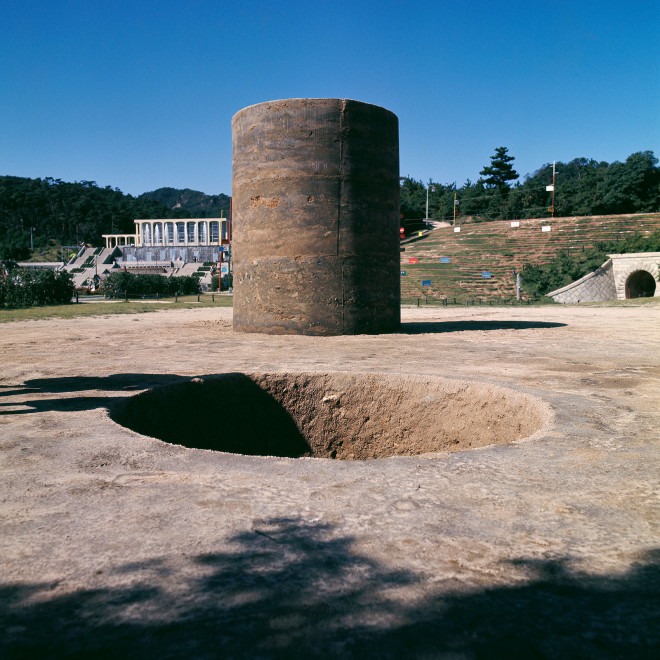
In 1980 Kitagawa wrote about Nobuo Sekine’s Phase-Mother Earth (first created in 1968) at the Suma Rikyu Park that he saw in Kobe on his way home from the Osaka Expo. The work is a monument of a 2.7 meter-tall cylinder of earth placed next to a cylindrical hole in the ground, both of which eventually deteriorated. Kitagawa states, “Seeing the temporal earth mound’s once-ness of the work left a lasting impression of a special encounter, magnified by the realization that it would be returned back to the ground over time.” This strong impression of the artwork led him to question Japan’s long history of canonizing the West and of embracing trends uncritically. Kitagawa’s focus on Sekine’s work highlights the way that Western artists and critics who were ignorant of Sekine missed a chance to articulate a profound development in international Earth Works. He faults this shunning of indigenous art histories and hybrid art histories for misinterpretations of Japanese art as it is perceived through the Western gaze.
For example, Kitagawa suggests that Nobuo Sekine’s work can be interpreted as being rooted in Nanga, a school of Japanese interpretations of Chinese-style literati painting from the Edo period. Nanga was a school of painting that was of questionable value, according to influential Western critics such as Ernest Fenollosa, because it seemed derivative. According to Kitagawa, the works Phase of Nothingness—Black, and Phase of Nothingness—Omou tsubo, are characterized by recognizable Nanga traits called koppouyouhitsu (expressive line, or in Chinese, “gu fa young bi”). In addition to this formalistic connection to the rhythms of nature favored by Nanga, Kitagawa points to the artist’s disengagement from the artwork as demonstrated in Sekine’s use of plastic reinforced by fiber in the objects exhibited in Europe in 1977.
Western critics, display an Orientalist desire to associate Japanese artwork with Zen, were displeased by his use of plastic to make the series, which strayed away from the use of “natural” materials that were commonly utilized by Mono-ha artists. Kitagawa, on the other hand, describes Sekine’s aesthetic as “sento-rock and sento-painting aesthetic” (Public bath rock, and public bath painting aesthetic: Public baths often have rocks and paintings as “kitsch” secondary nature aesthetics) as opposed to say, “Ryoanji rock garden rock aesthetics,” which is a persistent association with these Japanese artists’ works. As recently as in January 2014, W Magazine describes Sekine’s Blum and Poe exhibit in these terms: “Sekine’s first solo show in North America includes elemental sculptures that invite zen-like mediations.” Kitagawa counters this reading in 1980, concluding that Sekine’s unapologetic use of plastic is his way of providing a context for the object and the greater narrative of the Mono-ha to exist in a pluralistic history.
Furthermore, Kitagawa describes Sekine’s broader goal to create a “bathtub for the bath rock to exist,” which is a metaphor similar to Theaster Gates’s remarks about making “the thing that makes the thing.” This desire for a revisionist art historical perspective that takes into account international-local as well as global-local perspectives is the foundation for the Echigo-Tsumari Art Triennale.
The West’s ignorance of the “locale’s outward gaze” helps explain the limited recognition that Kitagawa and the Echigo-Tsumari Art Triennale have received in the United States. Examples of these kinds of misunderstandings can be documented throughout cross-cultural artistic exchange.
For instance, a Gutai Invitational show is described by The New York Tribune as, “anything but Japanese… crushingly Western when Western painters have taken to looking East for deeper, darker rhythms.” Ming Tiampo suggests that postwar Japan was regarded by the West as a source of exotic inspiration, but never considered to be the producers of truly creative, original, and unique works of art. Critic Pierre Restany, writing about performance art of the1960s, identified the serious consequence of this cultural blind spot: “The troubling coincidence,” he wrote, was that “the ‘performers’ of New York Happenings would have had a direct precursor in Japan, if they paid attention.” If artists from the United States at this time lacked the “outward gaze” altogether, one result was that work from Japan was commonly misunderstood as derivative.
In the years following his active involvement in the 1960 ANPO protests and other actions on University curriculum and environmental concerns, Kitagawa’s various community-building activities shaped the vision that would eventually become ETAT. This new notion of community and horizontal interactions characterize Kitagawa’s earliest involvement with art practices. His view of art as a catalyst for developing community is evident in even his earliest venture, which was to establish the Julia Pempel Studio in 1971. The Julia Pempel interdisciplinary collective studio produced art and posters and organized visual and performance events. They developed Chanson performances with elaborate sets and worked with graphic artists such as Awazu Kiyoshi and Yokoo Tadanori to screen print posters for various cultural events. In 1978 he established a “slow food” restaurant that featured local and regional Japanese specialty foods near the Julia Pempel Studio. He also created a publication called Penguin Question, which was a radical art and design magazine, and the Art Front Gallery was established in 1982. Perhaps it is through Kitagawa’s activism that he found philosophical grounding in the Marxist theory of the time, and perhaps it is the Marxist ideal of horizontal interactions among individuals from various disciplines that allowed for inherently interdisciplinary approaches in these cultural development projects and practices.
In mid-career following his activism of the 1960s and 1970s, Kitagawa actively pursued environmental justice. In 1981, he organized and produced a nine-day symposium on Minamata disease, a painful and often lethal set of conditions caused when people consumed methylmercury accumulated in fish through industrial wastewater contamination. The symposium was developed for the screening of a documentary film by Tsuchimoto Noriaki based on the Minamata Mural by husband and wife muralists Iri Maruki and Toshi Maruki (“Minamata no zu—Monogatari” 35mm, 16mm/color/111min). (Tsuchimoto Noriaki created another documentary about Minamata in 1971.) Tsuchimoto, along with the Marukis, Kitagawa Fram, and artist Kikuji Yamashita, were panelists who discussed interdisciplinary approaches to the environmental destruction through documentary film making, photographic research, activism, and reportage. As a native of the Niigata region, which also experienced mercury poisoning of the Agano River area in 1950s and 1960s, Kitagawa describes being moved by Ishimure Michiko’s book Paradise in the Sea of Sorrow: Our Minimata Disease [See KJ 13, 1990, excerpts translated by Livia Monnet]. The book contains personal accounts of people affected by negligent disposal of mercury that caused the poisoning of Minamata, Kumamoto Prefecture. In 1981, in response to the symposium, Kitagawa says, “Activism, expression, and existence (the entirety of life) will be threatened by homogeneity or hierarchies unless we are in tandem, strong, resilient and empathetic to the earth and the sea.”
One can see Kitagawa’s developing environmental consciousness and long-term dedication to environmental justice and activism in one of the earlier examples of his written work in the popularized 1960s and 70s genre of Japanese reportage, documentary work that includes photorealistic drawings pointing to social problems. In 1975 Kitagawa wrote a reportage to inform the public about the problems that followed the development of Miyanaka Dam in 1920, created to supply electricity for the JR East train line and Greater Tokyo.
Organizing communities through activism has been a Kitagawa strategy since his youth, which was informed by the zeitgeist of student protests in Japan in the 1960s and 70s. For Kitagawa as for so many others, these protests were galvanizing as they linked to a broad debate about the threat of nuclear conflict and questions about Japan’s involvement in wars fought by the United States, such as the Korean War, which dramatically boosted the Japanese economy. According to interviews, Kitagawa was actively involved in various demonstrations at this time and was detained by the police twice at Waseda toosoo and Sunagawa toosoo. He suffered a concussion and lost consciousness in the latter and also participated in the notoriously intense Narita Airport protests in support of farmer friends whose agricultural lands were seized by the government. He also organized protests as a student at Tokyo National University of Art to challenge the establishment hierarchy of art and the curricular systems that support it, following which the university was shut down for two years.
In this climate, Kitagawa reflects proletariat ideals in his approach to the organization of communities. Ming Tiampo describes this ideal as being developed as a way for grassroots movements to assert their collective power to challenge authority. This sense of community is reflected in Kitagawa’s 1969 protests against art establishment hierarchies, which aligns with the attitudes expressed by other art movements of this era such as the Gutai and their disassociations with gadan, or art establishments. Kitagawa mirrors Tiampo’s description of Gutai as having “articulated a new notion of the group that drew its direction from the horizontal interaction of autonomous individuals rather than the vertical, hierarchical dictates of a group leader or government official. Gutai’s new notion of community was conceived of as compatible with individualism and furthermore theorized as essential for the development of the individual.”
The interdisciplinary approach to place-making, place identity, and restorative practices developed and produced by Kitagawa for the Echigo-Tsumari Art Triennale much later, can be traced to dialogue surrounding the historical Expo 70 (Banpaku) in Osaka. During that time, part of the discourse among artists questioned whether or not to participate. Members of Gutai were criticized for taking part in the Expo because they were seen as joining the nationalist propaganda and losing “avant-garde credentials” by institutionalizing their group. On the other hand, anti-Expo artists named Zero-Jigen performed “rituals” about their views against Expo 70. They saw it as a smokescreen for the ANPO treaty and criticized the United States and its involvement in wars that directly led to economic growth in Japan. More broadly, the Zero-Jigen objected to the commercialism and big power nationalism that “glorified the Imperial cause during World War II.” Individual artists were also part of this discourse. Okamoto Taro acted as the chief producer of the theme pavilion “Progress and Harmony,” yet despite playing this role, he publicly held an ambivalent position regarding Expo 70, even though his work, Tower of the Sun became an icon for the Banpaku. The 70-meter-high, Jomon-era-inspired humanoid sculpture expresses anti-Expo sentiment by boldly flipping what the exhibition organizers expected from the “modernist machines.” The production of the primitivist sculpture (which one could walk inside of) was intended to be placed like a “giant phallic tower” piercing through Tangei Kenzo’s mechanistic grand roof that was comprised of tightly conjoined modular metallic umbrella-like units that spanned the vast Festival Plaza.
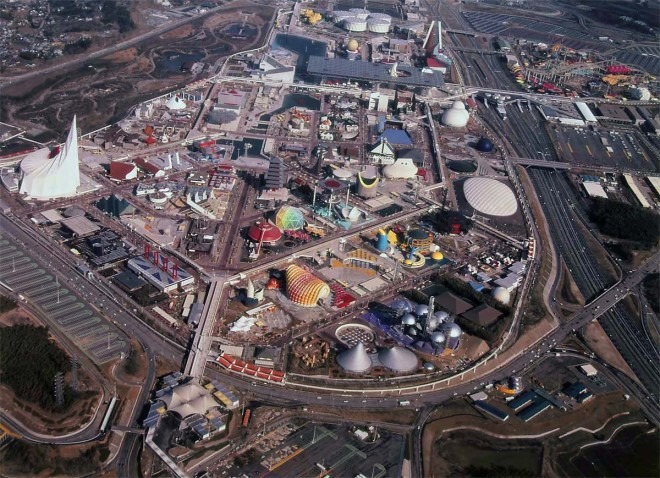
Expo 70 galvanized Japanese artists of the 1960s and 70s who pointed the way for Kitagawa’s site-specific trienniali by bringing art practices and viewers out of museums and gallery spaces to outdoor spaces “in a pine grove on the banks of Ashiya River, in the bombed-out ruins of a factory in Osaka, or in the grounds of an ikebana [flower arrangement] school.” These were the beginnings of site-specific installations that sought to establish a more immediate relationship between the Japanese public and art. The similarity with works curated by Kitagawa ends here. While Kitagawa’s work develops into an interdisciplinary, environmental social practice, even the so-called “environmental artists” whose works were strongly represented at Expo 70 were reinforcing dichotomies between nature and culture more common to Western art and thought. Although the polished stainless steel sculptures were intended to mirror the surroundings during a nadir of industrial pollution in Japan, the objects failed to address the destruction of the satoyama landscape of the Senri hills of Osaka to make way for Expo 70.
The divide between nature and culture also found expression in the divide between urban and rural. The prevailing urbanist sentiment was articulated at the Expo by the Metabolists, who sought to respond to the growing cities in Japan. They emphasized the explosive swelling of the Tokyo megalopolis by representing “cell divisions expanding into Tokyo Bay.” The Metabolists’ meticulously layered drawings demonstrate pseudo-city plans for simultaneously utopian and dystopian urban futures. Lin suggests that “their large scale, revolutionary urban schemes based on technocratic utopianism” could be viewed as disillusionment over techno-culture, and that this was understood as a destructive force in the age of the Vietnam War and the ecology movement. Many of the boldly futuristic works by artists and architects represented at Expo 70 shared similar attitudes of optimism towards technological and social progress until the energy crisis in 1973. Suddenly, there was doubt in the endorsement of fast-growing progress of the Megalopolis. The discourse of urban utopian/dystopian development marginalized rural planning and the drastic effects from migration of the population away from rural regions. Further shifts in attitudes about growth and urban development mirrored the rise of the bubble economy of the 1980s and the financial turmoil that followed. As Japan faces the lasting effects of the economic downturn and the March 11th, 2011 disasters of the Tohoku earthquake and tsunami, the restorative efforts of Kitagawa’s Echigo-Tsumari model gain even more relevance.
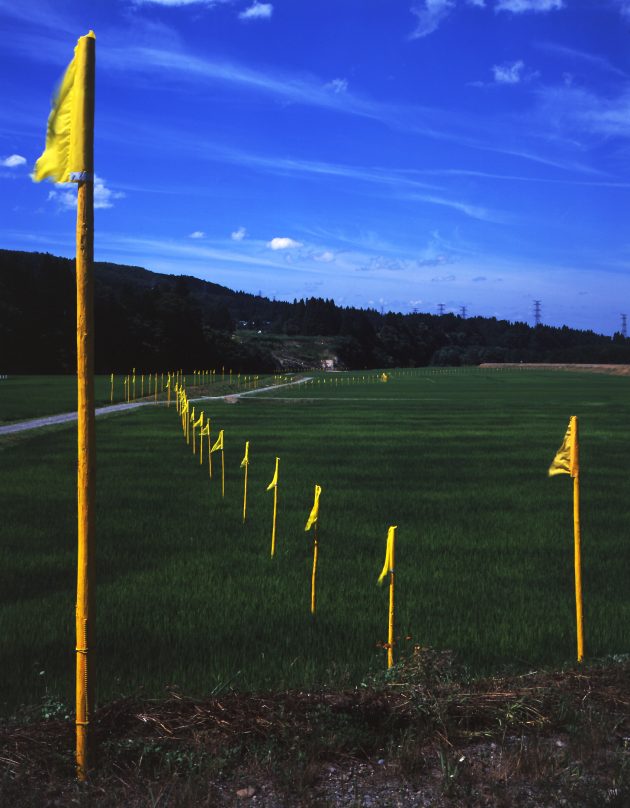 Kitagawa’s long-term focus on the environmental landscape of the Niigata region has evolved to curate and feature artists who address environmental issues at the Echigo-Tsumari Art Field Triennial. As a producer of the festival, he has worked with artist and public planner Yukihisa Isobe. Isobe is himself an independent producer but was also known as a post-war avant-garde painter in the 1960s. Through his involvement with Kitagawa, Isobe has been conducting research on the Shinano River as part of the “River Trilogy Project.” This work attempts to track and re-trace the course of the Shinano River as it was 100 years ago, using story poles to invite viewers to visualize a winding natural riverine topography that no longer exists. The project reveals the damming as having forced the isolation and dividing of the larger historical community that lived along the river banks and river basin into microtowns and hamlets. The drop in water levels of the Shinano River is also recorded by mapping lines along the knolls where the waterline used to be.
Kitagawa’s long-term focus on the environmental landscape of the Niigata region has evolved to curate and feature artists who address environmental issues at the Echigo-Tsumari Art Field Triennial. As a producer of the festival, he has worked with artist and public planner Yukihisa Isobe. Isobe is himself an independent producer but was also known as a post-war avant-garde painter in the 1960s. Through his involvement with Kitagawa, Isobe has been conducting research on the Shinano River as part of the “River Trilogy Project.” This work attempts to track and re-trace the course of the Shinano River as it was 100 years ago, using story poles to invite viewers to visualize a winding natural riverine topography that no longer exists. The project reveals the damming as having forced the isolation and dividing of the larger historical community that lived along the river banks and river basin into microtowns and hamlets. The drop in water levels of the Shinano River is also recorded by mapping lines along the knolls where the waterline used to be.
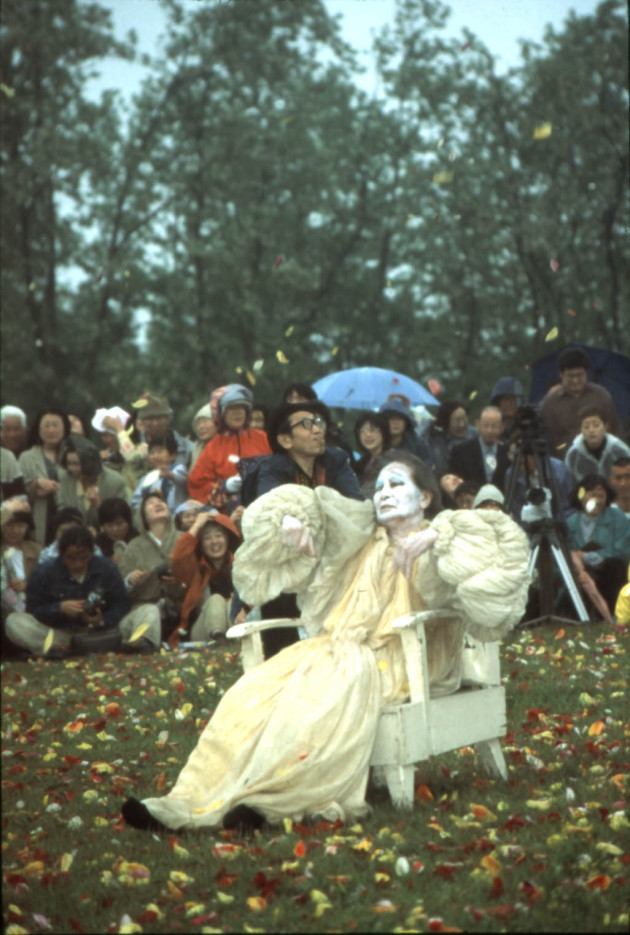 Other works such as Mierle Laderman Ukeles’s “Snow-Workers Ballet” exemplify Kitagawa’s celebration of marginalized peoples and movement away from museum and gallery spaces and into celebratory matsuri spaces with regional histories to re-invent localities. Ukeles and 13 professional snow-workers who live and work in Echigo-Tsumari only between November to April performed to celebrate their work and contributions to the community. In another well-documented performance, Ikebana artist Yukio Nakagawa dropped one million tulip petals from the sky on May 18th, 2002, which the communities of the region experienced as a metaphor for the ephemerality of life in the Echigo-Tsumari region. These celebratory, fleeting performances directly relate to traditional matsuri festivals, yet they can also be traced to the performances and art happenings of the 1960s and 70s.
Other works such as Mierle Laderman Ukeles’s “Snow-Workers Ballet” exemplify Kitagawa’s celebration of marginalized peoples and movement away from museum and gallery spaces and into celebratory matsuri spaces with regional histories to re-invent localities. Ukeles and 13 professional snow-workers who live and work in Echigo-Tsumari only between November to April performed to celebrate their work and contributions to the community. In another well-documented performance, Ikebana artist Yukio Nakagawa dropped one million tulip petals from the sky on May 18th, 2002, which the communities of the region experienced as a metaphor for the ephemerality of life in the Echigo-Tsumari region. These celebratory, fleeting performances directly relate to traditional matsuri festivals, yet they can also be traced to the performances and art happenings of the 1960s and 70s.
What may be most remarkable about the Art Triennale is the idea that artists engage the concepts of place-making, place identity, and the development of these ideas with the local residents of the region by collaborating with them. This commitment to a populist sense of community with one foot planted in activism and the other in art, directly evolved into the Echigo-tsumari festival model that anticipates and responds to the koureika effect of an aging population exacerbated by the continuous flight of young people away to the city. The festival is known for its massive grassroots efforts to include the local elderly population that has in turn helped to build and sustain the Echigo-Tsumari festivals. The kohebi committee, for example, is a volunteer group comprised of the local elders and university students from the Greater Tokyo area and other cities that come to support Echigo-tsumari activities.
The artwork, too, addresses the ways that revitalization begins with respect for aging residents as in Christiaan Bastiaans’s production of “The Real Lear,” which was photographed by Daido Moriyama. The play was based on long-term oral histories of the elderly residents of Tokamachi. Ten of the interviewees were also performers. Their childhood memories, anxieties about getting married, the labors of farming, the poverty of the land, affinity towards plants and flowers, and difficulties of life are layered to form a collective voice that brings critical engagement to the community as it bridges the past with the future. In this way, these art festivals have brought critical engagement among various communities. Kitagawa has connected artists, farmers, local residents, and researchers to redefine the notion of localities. By increasing awareness of the restorative processes of satoyama, the Echigo-Tsumari model unites the history of the landscape with aesthetics and local socio-economic issues.
1. Lucy R. Lippard, Undermining: A Wild Ride through Land Use, Politics, and Art in the Changing West. (New York: The New Press, 2014), 90.
2. Theaster Gates, “Yamaguchi Soul Manufacturing Corporation and a Potter Named Dave: The Need for Blackness in Contemporary Ceramics.” 2014 Keynote Address for the National Council on Education for the Ceramic Arts. http://blog.nceca.net/clay-in-my-veins-the-2014-nceca-keynote
3.Toru Terada, et al., “Refueling: Satoyama Woodland Restoration in Japan: Enhancing Restoration Practice and Experiences through Woodfuel Utilization.” Nature and Culture 5.3 (2010): 253.
4.Fram Kitagawa, Bijutsu wa chiiki wo hiraku: Daichi no geijutsusai 10 no shisou. (Tokyo: Gendaikikakushitsu Publishers, 2014), 210-13. (Author’s translation)
5.Reiko Tomii, “Historicizing ‘Contemporary Art’: Some Discursive Practices in Gendai Bijutsu in Japan,” Positions: East Asia Cultures Critique 12.3 (2004): 612.
6.Tomii, 629.
7. Fram Kitagawa, Kibou no bijutsu kyoudou no yume; Kitagawa Fram no 40nen 1965-2004. (Japan: Kadokawashoten, 2005), 76.
8.Kat Heriiman, “The Simple Complex.” W Magazine. January 2014. Web. Sep. 2014.
9. Kitagawa, Kibou, 77.
10. Ming Tiampo, Gutai: Decentering Modernism. (Chicago: University of Chicago Press, 2011), 142.
11. Tiampo, Gutai, 143.
12. Kitagawa, Kibou, 242.
13. Kitagawa, Kibou, 245.
14. Fram Kitagawa, Aato no Chikaku hendou. (Tokyo: Bijutsu shuppansha, 2013), 277.
15. Ming Tiampo, “Gutai Chain: The Collective Spirit of Individualism.” Positions 21.2 (2013): 392.
16. Alexandra Munroe, Japanese Art after 1945: Scream against the Sky. (New York: Harry N. Abrams, 1994), 258.
17. Midori Yoshimoto, “Expo ‘70 and Japanese Art: Dissonant Voices An Introduction and Commentary.” Review of Japan Culture and Society. December (2011): 3-6.
18. Tiampo, Gutai, 50.
19. Thomas R. H. Havens, Radicals and Realists in the Japanese Nonverbal Arts: The Avant-garde Rejection of Modernism. (Honolulu: University of Hawai’i Press, 2006), 163.
20. Doryun Chong, Tokyo 1955-1970: A New Avant Garde. (New York: Museum of Modern Art, 2012), 96.
21. Zhongjie Lin, Kenzo Tange and the Metabolist Movement: Urban Utopias of Modern Japan. (New York: Routledge, 2010), 228.
22. Lin, 227.
23. Kitagawa, Bijutsu, 32.
24. Kitagawa, Bijutsu, 199.
Chong, Doryun. Tokyo 1955-1970: A New Avant Garde. New York: Museum of Modern Art, 2012.
Chong, Doryun. Hayashi, Michio. Kajiya, Kenji. Sumitomo, Fumihiko. From Postwar to Postmodern Art in Japan 1945-1989: Primary Documents. New York: Museum of Modern Art, 2012.
Havens, Thomas R. H. Radicals and Realists in the Japanese Nonverbal Arts: The Avant-garde Rejection of Modernism. Honolulu: U of Hawai’i P, 2006.
Heriiman, Kat. “The Simple Complex.” W Magazine. January 2014. Web. Sep. 2014.
Kitagawa, Fram. Aato no Chikaku hendou. Japan: Bijutsu shuppansha, 2013.
—. Bijutsu wa chiiki wo hiraku: Daichi no geijutsusai 10 no shisou. Japan: Gendaikikakushitsu Publishers, 2014.
—. Kibou no bijutsu kyoudou no yume; Kitagawa Fram no 40nen 1965-2004. Japan: Kadokawashoten, 2005.
Lin, Zhongjie. Kenzo Tange and the Metabolist Movement: Urban Utopias of Modern Japan. New York: Routledge, 2010.
Lippard, Lucy R. Undermining: A Wild Ride through Land Use, Politics, and Art in the Changing West. New York: The New Press, 2014.
Marotti, William. “Japan 1968: The Performance of Violence and the Theater of Protest.” American Historical Review. February (2009): 101-111.
Munroe, Alexandra. Japanese Art after 1945: Scream against the Sky. New York: Harry N. Abrams, 1994.
Pinnington, Adrian. “Yoshimitsu, Benedict, Endo: Guilt, Shame and the Post-war Idea of Japan.” Japan Forum 13.1 (2001): 91-105.
Terada, Toru, Makoto Yokohari, Jay Bolthouse, and Nobuhiko Tanaka. “Refueling” Satoyama Woodland Restoration in Japan: Enhancing Restoration Practice and Experiences through Woodfuel Utilization.” Nature and Culture 5.3 (2010): 251-276.
Tiampo, Ming. “Gutai Chain: The Collective Spirit of Individualism.” Positions 21.2 (2013): 383-415.
Tiampo, Ming. Gutai: Decentering Modernism. Chicago: U of Chicago P, 2011.
Tomii, Reiko. “‘International Contemporaneity’ in the 1960s: Discoursing on Art in Japan and Beyond.” Nichibunken Japan Review 21 (2009): 123-147.
Tomii, Reiko. “Historicizing ‘Contemporary Art’: Some Discursive Practices in Gendai Bijutsu in Japan.” Positions: East Asia Cultures Critique 12.3 (2004): 611-641.
Winther-Tamaki, Bert. “Yagi Kazuo: The Admission of the Nonfunctional Object into the Japanese Pottery World.” Journal of Design History 12.2 (1999): 123-140.
Yoshimoto, Midori. “Expo ‘70 and Japanese Art: Dissonant Voices An Introduction and Commentary.” Review of Japan Culture and Society. December (2011): 1-12.

AMIKO MATSUO’s ceramic art investigates identity and the notion of invented traditions and cross cultural exchanges occurring throughout ceramic history. Her article on the ceramic village of Echizen appeared in Kyoto Journal 81, and she has also published on Japanese American ceramists and the work of Suzuki Osamu. With Brad Monsma, she is translator of Art+Place+Japan: A Vision for Renewal by Kitagawa Fram, forthcoming from Princeton Architectural Press in 2015. www.amikomatsuoceramics.com